 |
 |
 |
 |
 |
 |
 |
 |
 |
 |
|
KICP News
|
KICP News, 2017
On MLK Day King College Prep Cosmology Club Explores Dark Matter January 16, 2017  Related Links: KICP Members: Luca Grandi Former KICP Fellow Eric Dahl honored with a PECASE January 24, 2017  Read more:
Related Links: Scientific projects: COUPP/PICO Summer Undergraduate Researcher Michael Foley Wins AAS Chambliss Student Medal February 1, 2017 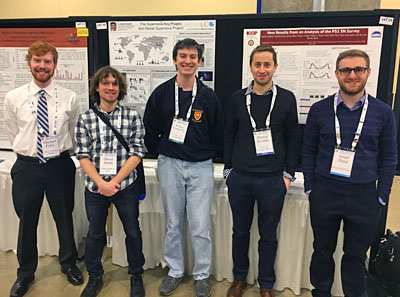 Read more Related Links: KICP Members: Richard Kessler; Daniel M. Scolnic Deflategate: Cold Wet Footballs, Ideal Gas Laws and Accusations of Cheating February 8, 2017  Twenty-eight (28) high school students in KICP's Space Explorers program put these arguments to the test. Over the course of two weeks, students critically evaluated over a dozen arguments made by both sides, ranging from court documents, to college lectures, to tweets. Despite the strong opinions, contradictory claims, and often factually incorrect information found in these arguments, the Space Explorers managed to identify the critical questions that needed to be resolved to determine if Deflategate could be caused by purely innocuous physics and designed an experiment to address them. Their experiment revolved around measuring the effect that wetness had on the rate at which cold footballs warm up and increase in pressure. To date their results are inconclusive. One trial found nothing suspicious about the pressure drop, and a second could not explain the low pressures in the Patriots' footballs. The Space Explorers themselves are split down the middle about how to interpret their results and will debate the best way to resolve this difference at the pre-Super Bowl Saturday class. Related Links: KICP Students: Philip Mansfield Hsin-Yu Chen has been selected for a Cronin Fellowship February 15, 2017 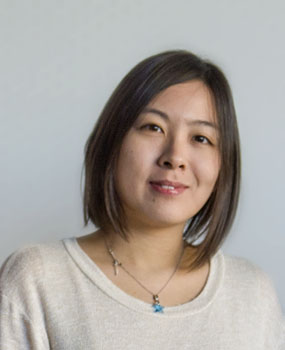 Congratulations Hsin-Yu! Angela V. Olinto, Homer J. Livingston Professor and Chair Department of Astronomy & Astrophysics Related Links: KICP Members: Daniel E. Holz; Angela V. Olinto KICP Students: Hsin-Yu Chen Scientific projects: Laser Interferometer Gravitational-wave Observatory (LIGO) The KICP will welcome 5 new Fellows in the Autumn of 2017 March 9, 2017 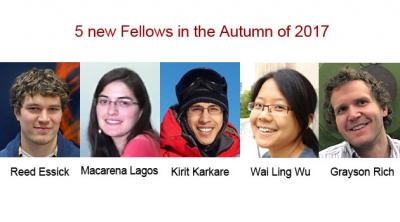 Macarena Lagos will receive her PhD from Imperial College London. Her research focuses on theoretical cosmology, specifically on analysing the viability of alternative gravity theories and developing methods to test gravity at large scales. At KICP, Macarena hopes to continue her current research and start new collaborations with its members. Kirit Karkare will join us as a joint Grainger and KICP Fellow after completing his degree at Harvard University, where he worked on hardware and systematics analysis for the BICEP/Keck CMB polarization experiments. At the KICP, he plans to continue working on the CMB with BICEP and SPT, and on detector development for line intensity mapping and measurements of high-redshift galaxies. Wai Ling (Kimmy) Wu did her graduate work at Stanford University with the BICEP/Keck team on the design, testing, and deployment of BICEP3 -- a small aperture CMB polarimeter that aims to target the inflationary gravitational wave B-mode signature. She then moved to UC Berkeley to work with the SPT team on the SPT-3G receiver and on delensing CMB B-mode maps, an important step to further constraint the inflationary B-mode signature. At KICP, she plans on extending her delensing work with BICEP/Keck and SPT datasets and looks forward to exploring new avenues to understand the cosmos with fellow KICP researchers. Grayson Rich carried out research at Triangle Universities Nuclear Laboratory (TUNL) while a graduate student at the University of North Carolina. As a part of the COHERENT Collaboration, he has been working towards the first observation of coherent, elastic neutrino-nucleus scattering (CEvNS): a low-energy neutrino-nucleus interaction arising from the standard model but still undetected over 40 years after its prediction. As a KICP Fellow and an Enrico Fermi Fellow at the Enrico Fermi Institute, he will maintain involvement with COHERENT and continue to advance an effort he spearheaded at TUNL to provide definitive characterizations of the responses of neutrino and dark matter detector systems, working with several groups at KICP and the broader astroparticle physics community. He also hopes to work with KICP and EFI members to exploit high-energy astrophysical signals, seeking insight into cosmological questions and the properties of fundamental particles. Related Links: KICP Members: Reed C. Essick; Kirit S. Karkare; Macarena Lagos; Grayson Rich; Kimmy (Wai Ling) Wu Scientific projects: BICEP2/The Keck Array/BICEP3; South Pole Telescope (SPT) Prof. Angela Olinto has been awarded a NASA grant for "Concept Study of the Probe Of Extreme Multi Messenger Astrophysics (POEMMA)" March 20, 2017 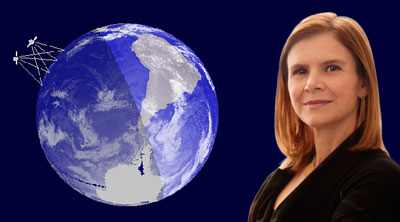 The team will receive funds for an 18-month comprehensive study. Related Links: KICP Members: Angela V. Olinto Scientific projects: Pierre Auger Observatory (AUGER) Abigail Vieregg will receive the 2017 Shakti P. Duggal Award March 27, 2017  Related Links: KICP Members: Abigail G. Vieregg The Event Horizon Telescope's historic quest April 13, 2017  Read more:
Related Links: KICP Members: Bradford A. Benson; John E. Carlstrom Scientific projects: South Pole Telescope (SPT) The Halo Boundary of Galaxy Clusters in SDSS April 24, 2017 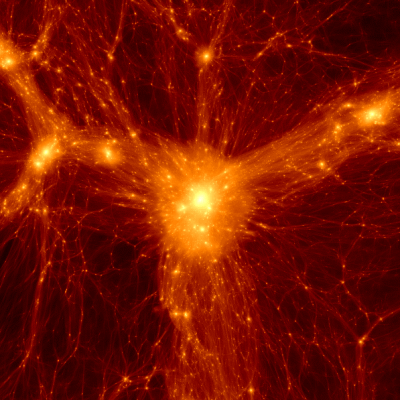 Credit: Benedikt Diemer, Philip Mansfield The existence of such physical edges associated with sharp density drops due to the density caustics formed by accreting matter was predicted by KICP researchers Benedikt Diemer and Andrey Kravtsov in 2014, as part of Diemers PhD research. In a follow-up study, Diemer, Kravtsov and a former KICP fellow Surhud More (currently at Institute of Physics of the Universe, Tokyo, Japan) have shown that the-edges can be considered to be natural physical boundary of dark matter halos that provide the gravitational "back-bone" for the structures observed in the galaxy distribution. In the recent study, co-led by Chihway Chang and Eric Baxter - a former KICP student and currently a postdoctoral fellow at the University of Pennsylvania - the density drop associated with the halo edges was detected in the galaxy distribution around cluster centers. Cosmological simulations show that massive galaxy clusters we see today have been accreting galaxies into their deep gravitational potential over the cosmic time. The process of galaxies "falling into" the cluster's potential well is a fairly clean and universal process that depends only on basic quantities of the cluster such as mass and accretion rate. One of the result of this simple picture is a sharp feature in the number density of galaxies around clusters - an imprint of the caustic formed by the infalling galaxies as they reach the first apocenter of their orbit, or the "edge" of the galaxy cluster. Researchers called the distance of the edge the "splashback" radius, as galaxies literally "splashing back" to that radius after they accrete onto cluster. Together with collaborators in UPenn and UIUC, that included KICP faculty Andrey Kravtsov, Chihway Chang and Eric Baxter, examined distribution of galaxies around a sample of clusters identified within the SDSS. The existence of the edge in the galaxy distribution within clusters was confirmed. In addition, the analysis revealed that properties of galaxies around cluster are sensitive to existence of the edge. Outside the splashback radius, the mix of red and blue galaxies was approximately independent of the distance from the cluster center, while inside the splashback radius the mix is abruptly changes towards a larger fraction of red galaxies. This indicates that the edge is a real dynamical feature and that majority of galaxies get transformed by the cluster environment from blue to red in less than one orbital period. 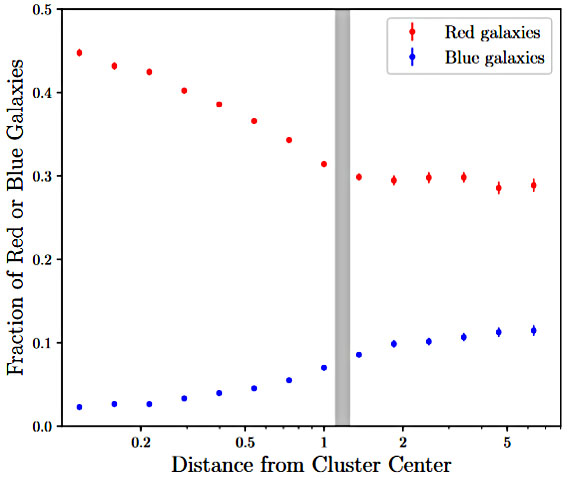 This figure shows the fraction of red and blue galaxies around galaxy clusters. The sharp change in the red fraction indicates that galaxy tend to turn red once they enter the edge of the cluster, which is marked by the grey vertical band. (Figure modified from the paper "The Halo Boundary of Galaxy Clusters in the SDSS".) Related KICP references:
Related Links: KICP Members: Chihway Chang; Andrey V. Kravtsov; Surhud More KICP Students: Eric J. Baxter; Benedikt Diemer; Philip Mansfield EUSO-SPB has been launched April 24, 2017  The EUSO-SPB instrument is carried by a superpressure balloon designed and launched by NASA's Columbia Scientific Balloon Facility. EUSO-SPB emerged from the JEM-EUSO project and uses the same principle of harnessing the earth's atmosphere to detect ultra high-energy cosmic rays. EUSO-SPB will observe the nitrogen fluorescence and Cherenkov photons produced by extensive air showers. Related Links: KICP Members: Angela V. Olinto Congratulations to KICP member Joshua Frieman! April 27, 2017  The Division of Astrophysics (DAP), organized in 1970, engages in observational and theoretical investigation that relates to the study of physical processes in stars and other discrete galactic sources, galactic structure and evolution, the early history and evolution of the Universe, and the Sun and solar activity. Division interests also have significant overlap with other APS divisions such as Particles and Fields, Nuclear Physics, and Plasma Physics. Related Links: KICP Members: Joshua A. Frieman Congratulations to KICP member Wayne Hu, newly inducted NAS member! May 1, 2017 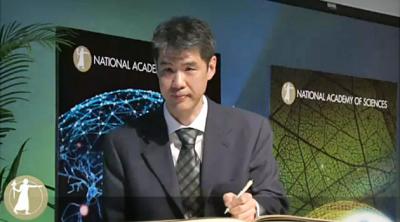 Members are elected to the National Academy of Sciences in recognition of their distinguished and continuing achievements in original research. Video of the Presentation Ceremony Related Links: KICP Members: Wayne Hu Congratulations to Dr. Michael Fedderke! June 9, 2017  "Michael's thesis work covers several important aspects of particle physics and cosmology. It includes detailed studies on the signal of dark matter annihilation in the galactic halo. After producing an interesting paper on the heavy particle production in the early universe, he delved into Higgs physics. He evaluated the potential of discovering new physics via fermionic Higgs portal, which has implications for the physics reach of both current and future colliders. In his most recent project, he has also constructed a model which addressed the little hierarchy problem in the composite Higgs scenario using cosmological evolution of an axion like field." - LianTao Wang, PhD advisor Michael has received a joint postdoc position at Stanford University and UC Berkeley. Related Links: KICP Members: Edward W. Kolb; Lian-Tao Wang KICP Students: Michael Fedderke Congratulations to Dr. Hsin-Yu Chen! June 12, 2017 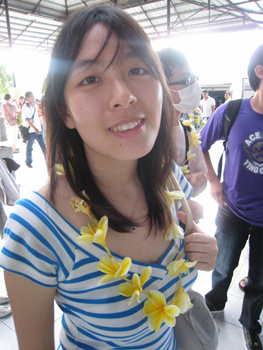 "Hsin-Yu's work is helping set the stage for the new era of gravitational-wave astronomy. She has played an active role within the LIGO collaboration in the analysis of our first detections, while also becoming a leader in the field of multi-messenger astronomy." - Daniel E. Holz, PhD advisor Hsin-Yu has received a postdoc position at the Black Hole Initiative (Harvard). Related Links: KICP Members: Daniel E. Holz KICP Students: Hsin-Yu Chen Scientific projects: Laser Interferometer Gravitational-wave Observatory (LIGO) Space Explorers Program Evaluation and Experiments Featured at the 2017 National Science Teachers Association (NSTA) Meeting Los Angeles, CA June 14, 2017 Randall H. Landsberg presented "Space Explorers: 25 Years of Inner-city Students Out of School Time Explorations" as part of the "mission possible" thread at the NSTA national conference. The talk included data on how students in the program are out preforming their peers and exemplar, hands-on, inquiry based experiments. The experiments both involved measurements but in very different realms: the size of the universe and the response rates of rods compared to cones in the human eye. 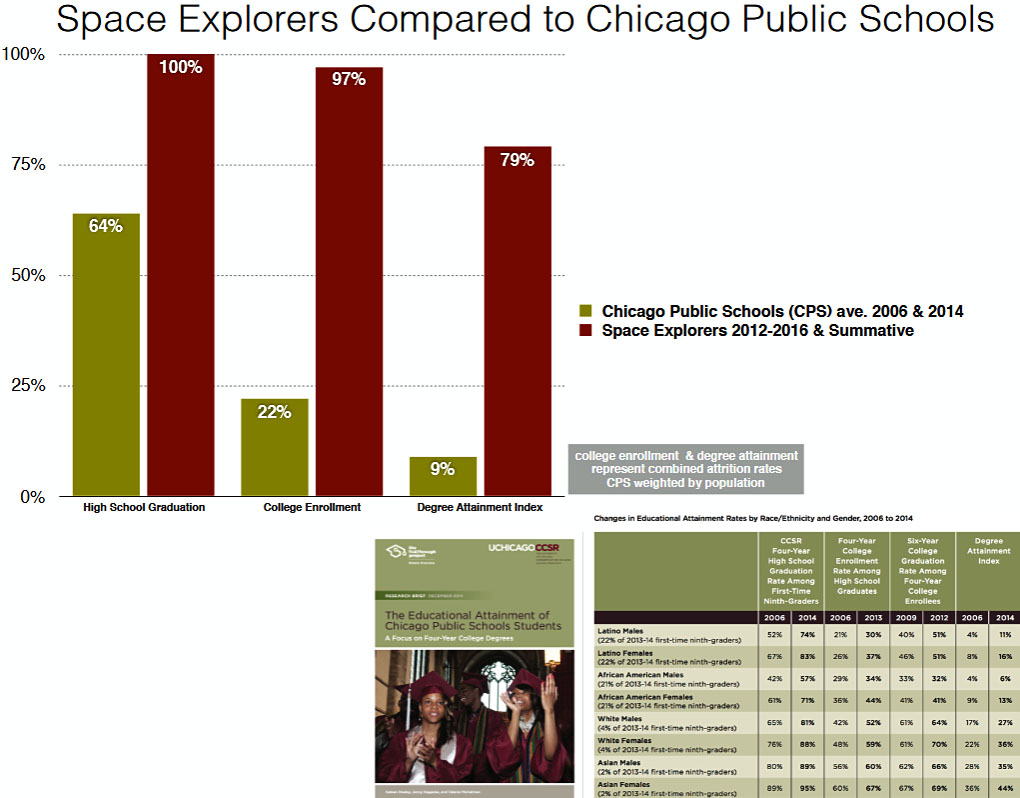 Space Explorers Compared to Chicago Public Schools. 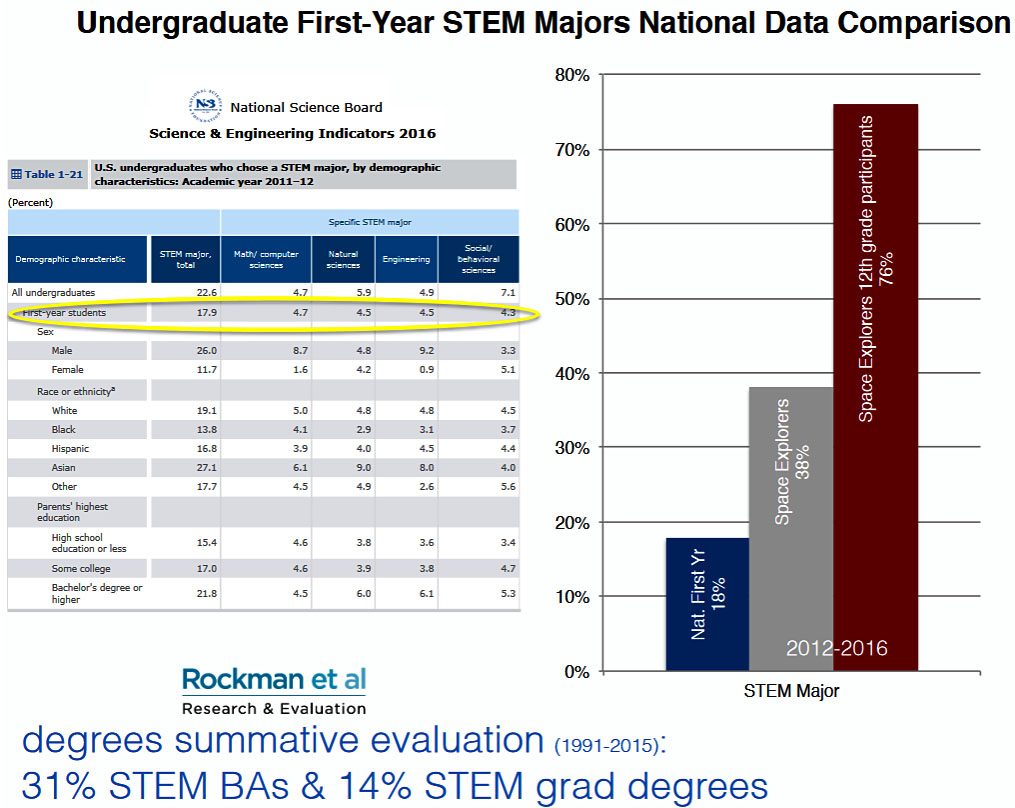 Undergraduate First-Year STEM Majors National Data Comparison. Presentation Abstract: Since 1991 Space Explorers has offered first generation, low income inner-city students and university astrophysics researchers the opportunity to explore together (with over one hundred contact hours a year). An external evaluation probed the impacts of this program on the hundreds of students and instructors involved. We will examine the evaluation findings, which map well to the recent NRC study on out of school time programs. We will also explore some of our favorite lab activities, hear about taking students to Yerkes Observatory for residential science institutes, and discuss best practices for university and community based organization partnerships. Take home new ideas for student labs and partnerships. 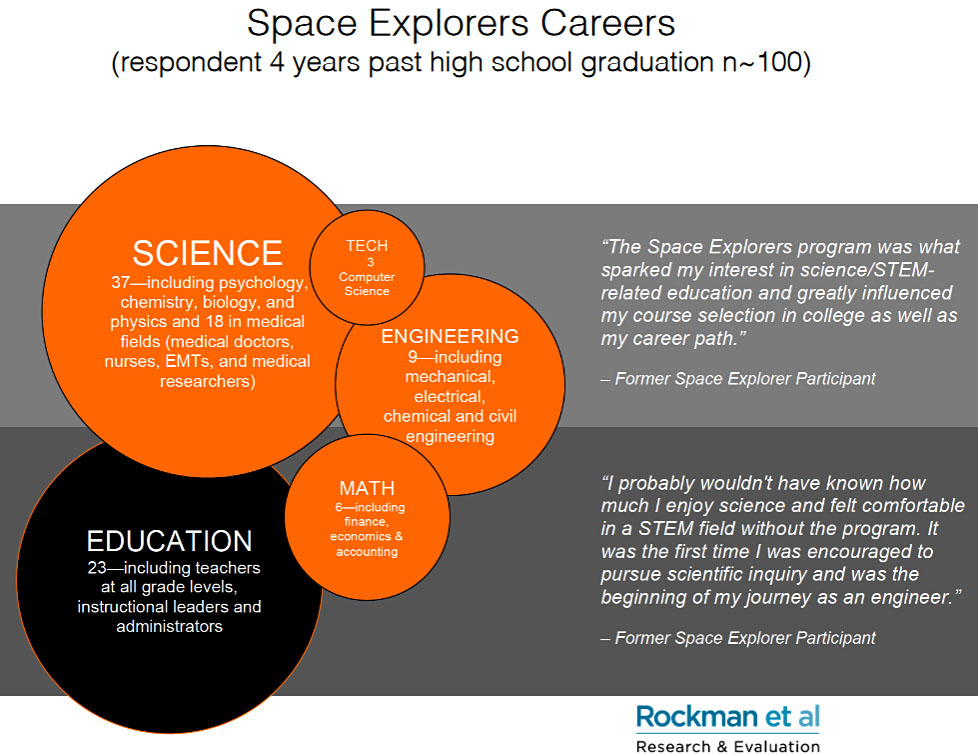 Space Explorers Careers (respondent 4 years past high school graduation n~100). Related Links: KICP Members: Randall H. Landsberg Cameron Liang has won a Harper Dissertation Fellowship June 16, 2017 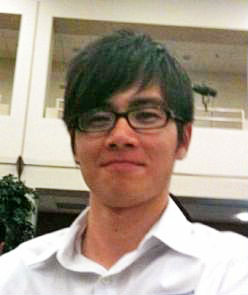 Related Links: KICP Members: John E. Carlstrom KICP Students: Cameron Liang Congratulations to Dr. Chen He Heinrich! June 19, 2017  Chen has received a postdoc position in cosmology at the Jet Propulsion Laboratory, NASA. Related Links: KICP Members: Wayne Hu KICP Students: Chen He Heinrich John Carlstrom becomes the new Chair of the Department of Astronomy & Astrophysics July 13, 2017  Effective October 1, 2017, John Carlstrom will become the Chair of Astronomy and Astrophysics. His scientific excellence will serve the department well in the coming years. I thank Angela Olinto for her excellent service as Chair of Astronomy and Astrophysics. I look forward to working closely with John as he takes on leadership of the Department. Please join me in congratulating him on this appointment. Rocky Kolb, Dean of the Physical Sciences Division Related Links: KICP Members: John E. Carlstrom; Edward W. Kolb; Angela V. Olinto Congratulations to Dr. Laura Mocanu! July 21, 2017 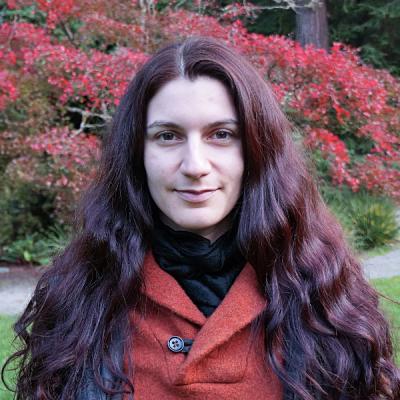 "Monica has make many important contributions to the analysis of South Pole Telescope CMB data. For her thesis she has used SPTpol temperature and polarization data to produce the most sensitive CMB lensing reconstruction of the mass distribution in the universe, paving the wave for SPT-BICEP B-mode delensing and other cosmological analysis." - John Carlstrom, Ph.D. advisor Laura has received a Postoctoral fellowship at the University of Oslo. Related Links: KICP Members: John E. Carlstrom KICP Students: Laura M Mocanu Scientific projects: South Pole Telescope (SPT) Congratulations to Dr. Alessandro Manzotti! July 24, 2017 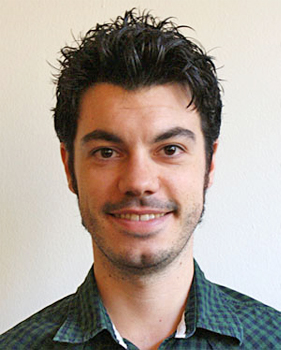 "Alessandro led the team that carried out the first 'de-lensing' of the polarization in the cosmic microwave background. Using data from the South Pole Telescope, the team used software to undo what billions of years of propagation through the clumpy universe has done: distorted the pattern of polarization. This first demonstration is the harbinger of what will ultimately become an essential tool in analyses of future SPT CMB-Stage 4 data." - Scott Dodelson, Ph.D. advisor Alessandro has received a Lagrange Fellow position at the Institut d'Astrophysique de Paris. Related Links: KICP Members: Scott Dodelson KICP Students: Alessandro Manzotti Scientific projects: South Pole Telescope (SPT) Congratulations to Prof. Hsiao-Wen Chen! July 26, 2017 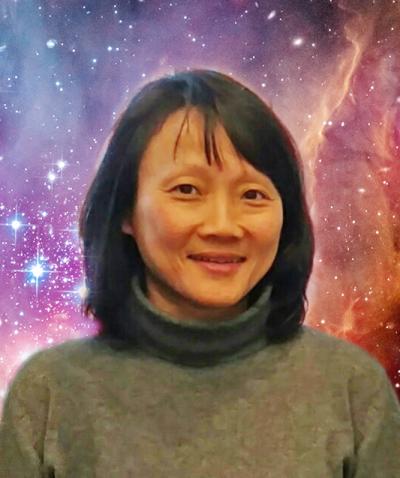 Department News: July 26, 2017 Dear Colleagues, It is my great pleasure to announce that Professor Hsiao-Wen Chen has been promoted to Full Professor. Please join me in congratulating Professor Chen! Angela V. Olinto, Homer J. Livingston Distinguished Service Professor and Chair Department of Astronomy & Astrophysics Related Links: KICP Members: Hsiao-Wen Chen; Angela V. Olinto Joshua Frieman becomes the new Deputy Director of the KICP September 8, 2017 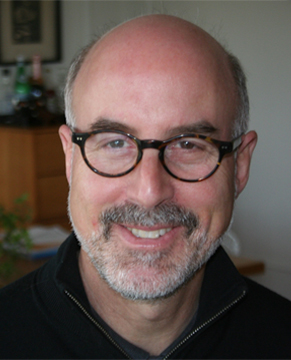 Frieman received his Ph.D. from UChicago in 1985 and is a Scientist III at Fermilab, a Professor of Astronomy & Astrophysics, part time, at UChicago, and a founding member of the KICP. He is also the current Director of the Dark Energy Survey (DES), an international, collaborative effort to map hundreds of millions of galaxies, detect thousands of supernovae, and find patterns of cosmic structure that will reveal the nature of the mysterious dark energy that is accelerating the expansion of our Universe. Frieman's honors include Honorary Fellow of the Royal Astronomical Society, Fellow of the American Academy of the Arts and Sciences, Fellow of the American Association for the Advancement of Science, and Fellow of the American Physical Society. Related Links: KICP Members: John E. Carlstrom; Joshua A. Frieman Scientific projects: Dark Energy Survey (DES) Observation of coherent elastic neutrino-nucleus scattering September 15, 2017 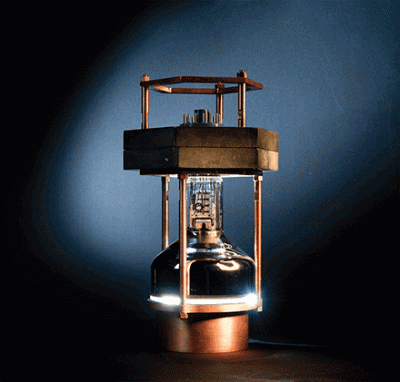 Photo: Jean Lachat/University of Chicago Links:
Related Links: KICP Members: Juan I. Collar KICP Students: Bjorn Scholz Scientific projects: Coherent Germanium Neutrino Technology (CoGeNT) The KICP wishes Kavli IPMU a Happy 10th Birthday! September 27, 2017  Kavli Institute for the Physics and Mathematics of the Universe (Kavli IPMU) Galileo once remarked that mathematics is the language of the universe, and it is the firm belief at the Kavli Institute for the Physics and Mathematics of the Universe (Kavli IPMU). But here, a combination of different approaches based on theoretical physics, experimental physics, and astronomical observations is used for seeking answers to profound problems in cosmology. The Kavli IPMU, an institute within the University of Tokyo, brings together a wide range of researchers -- from pure mathematicians and string theorists to experimental particle physicists and observational astronomers -- in a truly multi-disciplinary and collaborative environment. First established in 2007 under a Japanese government initiative as the Institute for the Physics and Mathematics of the Universe (IPMU), the Institute received an endowment from The Kavli Foundation in early 2012 and became the Kavli IPMU. Read more >> Congratulations to Dr. Michael Florian! October 3, 2017  "Michael has been working at the interface of simulations and observations to develop statistical methods to quantify the morphology of strongly lensed galaxies, in the image plane. Such techniques bypass the extensive effort (both in analysis, and additional data) required to model strong lensing systems and generate source plane images. His work in particular sets a standard for upcoming space missions such as JWST, Euclid and WFIRST; he will be leaving us to go to take a NASA Postdoctoral Fellowship working the JWST group at Goddard Space Flight Center." - Michael Gladders, Ph.D. advisor Michael has received a NASA Postdoctoral Fellowship at Goddard Space Flight Center. Related Links: KICP Members: Michael D. Gladders KICP Students: Michael Florian Gravitational Waves Events October 13, 2017 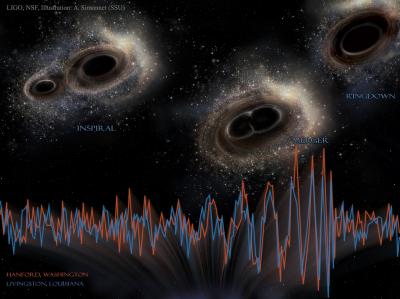 FIRST, On Monday, October 16th at 09:00 CDT, the National Science Foundation will host a press briefing at the National Press Club in Washington, D.C., bringing together scientists from the Laser Interferometer Gravitational-Wave Observatory (LIGO) and Virgo collaborations, as well as representatives from some 70 observatories. This will be live-streamed and we will set up a live viewing with some of the involved University of Chicago scientists in the lobby of ERC, as well as in room 201 of the Physics Research Center. The press briefing will begin with an overview of new findings from LIGO, Virgo and partners that span the globe, followed by details from telescopes that work with the LIGO and Virgo collaborations to study extreme events in the cosmos. The discovery of gravitational-waves by LIGO opened a new window to the Universe and involved several UChicago scientists. This year's Nobel Prize in Physics recognized three scientists for their contributions to the LIGO detector and the first observation of gravitational waves. SECOND, there will be a special, more technical colloquium on the topic Monday, October 16th at 4:00 p.m. CDT in ERC 161, featuring University scientists Daniel Holz and Joshua Frieman, followed by discussion and comments by Holz, Frieman, Hubble Fellow Dan Scolnic, University Professor Wendy Freedman, and students and postdocs involved in the new findings. Following the discussion there will be a reception in the atrium. THIRD, there will be an event on Tuesday, October 17th from 5:00 - 7:00 p.m. in Kersten Physics Teaching Center (KPTC 120), consisting of about 5 short presentations by graduate students and postdocs and a Q&A/discussion. This will be geared more to the general public and university undergraduates. I encourage you to join us for any of these special gatherings. Rocky Kolb, Dean of the Physical Sciences The University of Chicago Related Links: KICP Members: Reed C. Essick; Wendy L. Freedman; Joshua A. Frieman; Daniel E. Holz; Edward W. Kolb; Daniel M. Scolnic KICP Students: Zoheyr Doctor; Maya Fishbach Scientific projects: Laser Interferometer Gravitational-wave Observatory (LIGO) Congratulations to Dr. Bjorn Scholz! October 16, 2017 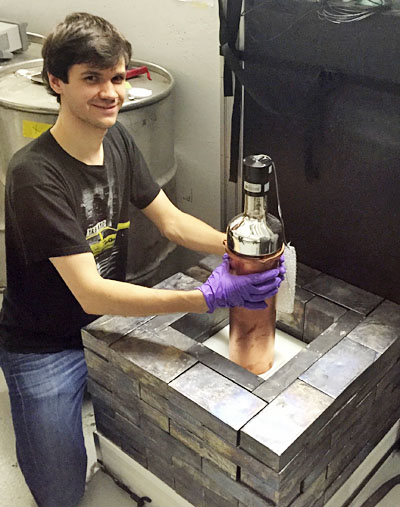 "Bjorn's thesis contains a much coveted result in neutrino physics, the first observation of coherent neutrino-nucleus scattering. Bjorn performed an exquisitely careful detector calibration and analysis of the data, resulting in the extraction of just a couple of hundred events, in near-perfect agreement with the Standard Model predictions for this process. Bjorn's thesis marks the starting point of a new area of activity within neutrino physics, one that may lead to exciting discoveries." - Juan Collar, Ph.D. advisor Related Links: KICP Members: Juan I. Collar KICP Students: Bjorn Scholz Scientific projects: Coherent Germanium Neutrino Technology (CoGeNT) Congratulations to Daniel Holz and Dan Hooper! October 20, 2017 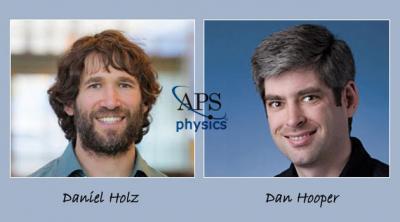 Daniel Holz Citation: For contributions to relativistic cosmology including the effect of gravitational lensing of distant SNe on measuring cosmic distances, the use of standard sirens to precisely determine cosmic distances, and his significant role in LIGO discovery of gravitational waves. Nominated by: Division of Gravitational Physics Dan Hooper Citation: For pursuing the identity of dark matter by combining careful analysis of observational data with theoretical ideas from both particle physics and astrophysics. Nominated by: Division of Astrophysics Read more >> Related Links: KICP Members: Daniel E. Holz; Daniel Hooper Scientific projects: Laser Interferometer Gravitational-wave Observatory (LIGO) Kavli Roundtable: New Map of Dark Matter Puts the Big Bang Theory on Trial October 31, 2017 The prevailing view of the universe has just passed a rigorous new test, but the mysteries of dark matter and dark energy remain frustratingly unsolved. A NEW COSMIC MAP was unveiled in August, plotting where the mysterious substance called dark matter is clumped across the universe. To immense relief - and frustration - the map is just what scientists had expected. The distribution of dark matter agrees with our current understanding of a universe born with certain properties in a Big Bang, 13.8 billion years ago. But for all the map's confirmatory power, it still tells us little about the true identity of dark matter, which acts as an invisible scaffold for galaxies and cosmic structure. It also does not explain an even bigger factor shaping the cosmos, known as dark energy, an enigmatic force seemingly pushing the universe apart at ever greater speeds. Tantalizingly, however, a small discrepancy between the new findings and previous observations of the early universe might just crack open the door for new physics. To discuss these issues, The Kavli Foundation turned to three scientists involved in creating this new cosmic map, compiled by the Dark Energy Survey. The participants were:
Read more >> Related Links: KICP Members: Scott Dodelson Scientific projects: Dark Energy Survey (DES) Congratulations to Eric Dahl! November 2, 2017 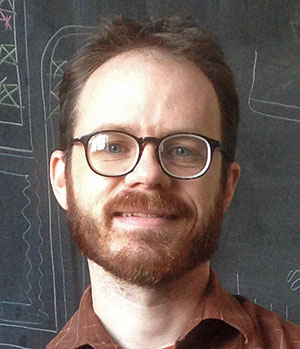 Citation: "for fundamental contributions to the development of new techniques for the direct detection of dark matter, including the bubble chamber and xenon time projection chamber." Henry Primakoff Award for Early-Career Particle Physics To recognize outstanding contributions made by physicists who are just beginning their careers, and to help promote the careers of exceptionally promising young physicists. The prize is given annually and will consist of $1,500 and a certificate citing the contributions of the recipient, plus an allowance for travel to an APS meeting to receive the award and deliver an invited lecture. Read more >> Related Links: KICP Members: Eric Dahl Scientific projects: COUPP/PICO Congratulations to Dan Scolnic! November 8, 2017 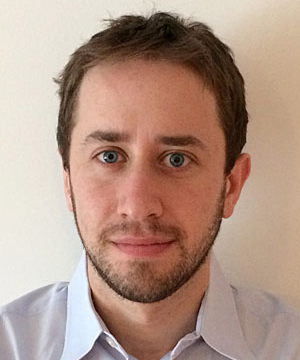 Related Links: KICP Members: Daniel M. Scolnic Congratulations to Stephan Meyer! December 19, 2017  Learn more Related Links: KICP Members: Stephan S. Meyer Scientific projects: Wilkinson Microwave Anisotropy Probe (WMAP) |





 Overview
Overview